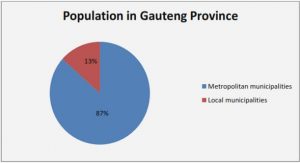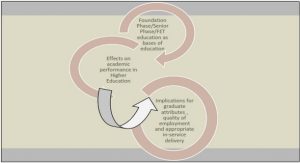Get Complete Project Material File(s) Now! »
THE THREE MODES OF REPRESENTATIONS
A conceptual framework is a system of concepts, assumptions, expectations, beliefs and theories that supports and informs research (Maxwell, 2005, p. 33). The conceptual framework of this study is rooted in the following representation of knowledge:
Visual/graphical – where students‟ interpretations are analysed from the graphs, diagrams (both in 2D and in 3D), or other forms of pictorial illustration they produce. Algebraic/symbolical – where students‟ interpretations of the visual/graphical are analysed from the equations/expressions, symbols and notations they use. Numerical – where students‟ interpretations are analysed from the calculations they use (points of intersection, intercepts with the axes and other important points) when drawing graphs, computations and manipulation of the given integrals (using equations/expressions and symbols) to calculate area and volume, and their further applications.
MY CONCEPTUAL FRAMEWORK INVOLVING THE FIVE SKILL FACTORS
This research focuses on students‟ difficulties involving VSOR. In learning about VSOR, students are expected to sketch graphs, shade the region bounded by the graphs, show the representative strip for the shaded region, rotate the graphs (focusing on the shaded region) and calculate the volume generated. In so doing the students are expected to use visualisation as a tool for learning in order to translate the visual graphs to algebraic equations and to do the manipulations that follow. Based on these premises and also relating to literature, a theoretical framework was developed.
The theoretical framework is based on five skill factors given in Table 3.1. The five skill factors were developed from the analysis of the section based on VSOR from the N6 textbooks, to determine which skills students need for competency. Each skill factor is categorised according to elements (that clarify the skill factor in detail), as shown in Table 3.1 below, 11 elements in total. In order to investigate the difficulties, students‟ written and verbal interpretations were analysed in line with the five skill factors. The use of writing in this study helped the researcher monitor the students‟ conceptual understanding level required for VSOR. According to McDermott and Hand (2010, p. 519), writing in the science classroom is viewed as a communication tool as well as an epistemological tool to develop conceptual understanding.
Skill Factor II: Three-dimensional thinking
Skill factor II also involves translation from 2D diagrams to 3D diagrams (Element 6) and translation from 3D diagrams to 2D diagrams (Element 7). In learning of VSOR students draw graphs, giving rise to two-dimensional shapes. The two-dimensional shapes are given in terms of the region within the given parameters, which upon rotation result in threedimensional objects. The strip drawn approximates the area within the given parameters. The drawn strip for the area selected (in 2D) is used to calculate area from integration. If the selected area is rotated, students should use integration to compute the volume generated using the disc, washer or shell methods. In order to compute the volume generated as a result of rotating the region bounded by those graphs, students are expected to work in one dimension to identify the points that serve as parameters to these graphs. Students are then expected to relate (transfer) to prior knowledge regarding Riemann2 sums when working in two-dimensions to compute the generated volume in three-dimensions as a solid of revolution.
In generating a solid of revolution, the students have to argue that when a 2D object (e.g. a segment, a circle, a square, a triangle, a sinusoidal curve or a free shape curve) is rotated in 3D around a vertical axis it can generate a variety of 3D rotational objects (Christou et al., 2008, p. 5). If the students fail to make such connections, it may be because their mental schemes do not recognise what they see. This may be due to their internal representations which conflict with the external representations (Knuth, 2000). For example, a student may not have the necessary tools (preknowledge or cognitive skills) to deal with the data presented by the external representation (diagram/graph) and internalise it. With Skill factor II, as it was with Skill factor I, all three modes of representations overlap. As students draw graphs or diagrams (in 2D or 3D), they use general manipulation skills to calculate the intercepts with the axis and other important points, hence they operate in the numerical representation. At the same time they are translating between the given equations/symbols and the visual/graphical representation, both in 2D and in 3D.
CHAPTER 1: CONCEPTUALISATION OF THE STUDY
1.1 Setting
1.2 Motivation for the study
1.3 The problem description
1.4 Research question
1.5 Significance of the study
1.6 Conclusion
1.7 Overview of the chapters
CHAPTER 2: LITERATURE REVIEW
2.1 Graphing skills and translation between visual graphs and algebraic/expressions
2.2 Translation between 2D and 3D diagrams
2.3 Translation between continuous and discrete representations
2.4 General manipulation skills
2.5 General level of cognitive development
2.6 Contextual factors affecting learning
2.7 Conclusion
CHAPTER 3: CONCEPTUAL FRAMEWORK
3.1 The three modes of representations
3.2 My conceptual framework involving the five skill factors
3.3 The three modes of representations and the level of cognitive development
3.4 Procedural and conceptual knowledge
3.5 Procedural and conceptual knowledge within the five skill factors
3.6 Related frameworks
3.7 Conclusion
CHAPTER 4: RESEARCH DESIGN AND METHODOLOGY
4.1 Research strategy
4.2 Data collection and analysis
4.3 Validity
4.4 Reliability
4.5 Generalisation
4.6 Ethical consideration
4.7 Delineation of the study
4.8 Limitations of the study
4.9 Summary
CHAPTER 5: PRELIMINARY AND PILOT STUDIES
5.1 Part 1: Preliminary study in July 2005
5.2 Part 2: The pilots study in October 2006
5.3 Conclusion from the results
CHAPTER 6: QUESTIONNAIRE AND EXAMINATIONS
6.1 Presentation and analysis of the results from the 23-item instrument (questionnaire)
6.2 Examination analysis and the detailed written examinations responses
6.3 Summary of the examination analysis
6.4 A model question paper
CHAPTER 7: CORRELATING THE ELEMENTS
7.1 Non-parametric tests: Kendall tau ()
7.2 Parametric tests: Pearson (r)
7.3 The Pearson‟s correlation and the level of significance for the 151 students
CHAPTER 8: OBSERVATIONS AND AN INTERVIEW
8.1 Classroom observations
8.2 Interview with one student
8.3 Conclusion
CHAPTER 9: INTERPRETATIONS AND CONCLUSIONS
9.1 Overview of this research
9.2 Addressing the research questions for this study
9.3 Answering the research question for this study
9.4 Recommendations of the study
9.5 Limitations of the study and directions for further research
REFERENCES
Philosophiae Doctor: Natural and Agricultural Sciences






